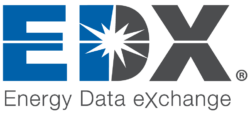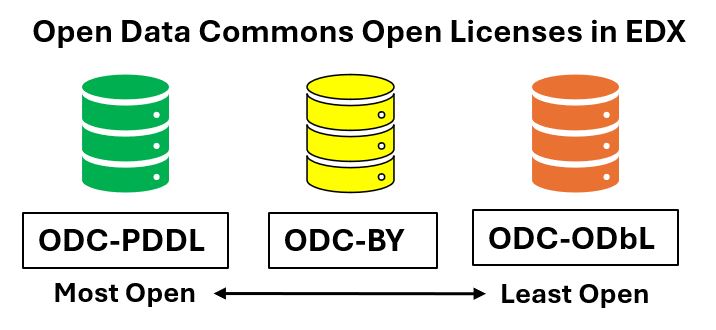License Guide
Understanding Data Licenses
Data licenses define the conditions for the use, modification, and distribution of data and other digital products. Selecting the right license is essential to balance accessibility with the rights of the data creator and to adhere to relevant regulations. These licenses are broadly categorized as either open or closed.
Open licenses allow data to be freely used, modified, and shared, often with minimal restrictions such as attribution or share-alike cluses. All resources published on EDX requires an open license.
Closed licenses restrict access and use to specific individuals or entities, often requiring explicit permission for modifications or reuse. In some cases, regulatory terms may supersede general guidance provided in this document. Selecting closed licenses may be applicable for select resources loaded into a private workspace.
Coordinate with your Federal Project Manager, appropriate contracting authority, or legal counsel to verify you are selecting the appropriate license if you are unsure of applicable requirements.
The license you choose depends on multiple factors such as:
- Resource Type
- User Role
- Intended Use and Restrictions
- Attribution Requirements
Resource Type
The diverse range of resource types submitted to EDX have distinct legal, privacy, and ownership attributes that will impact the most suitable license selection.
- Dataset: A collection of data gathered from research, experiments, observations, etc.
- Presentation: Visual or oral displays of information. approval required for Office of Scientific and Technical Information (OSTI) Digital Object Identifiers (DOIs).
- Publication: Written works, such as articles, reports, or books.
- Tool/Source Code/Model: Programs or applications that perform specific tasks, computational frameworks, algorithms, or systems used for analysis, simulation, or problem-solving.
User Role
Each Role is responsible for assigning an appropriate license to each resource contributed to EDX. Assigning a license for all public resources is part of the submission metadata and is subject to the review and approval process. For specific details on NETL’s policies or to obtain legal counsel to understand intellectual property rights and obligations, please submit an Office of Chief Counsel – Intake Form.
- NETL/DOE Federal and Contractor Researchers: Ensure all resources are assigned a license according to role requirements.
- Federal Researcher: Works published for public access by federal employees are designated as “works of the U.S. Government” and are NOT eligible for copyright protection.
- Prime Contractor: Can apply for patent, copywrite. However, federal contractors should prioritize reviewing their specific contract for Federal Acquisition Regulations (FAR) clauses and requirements related to data rights and licenses.
- Subcontractor: Review the terms outlined in prime contractor agreement for clauses that flow down requirements from the Prime’s federal contract and communicate with the Prime contractor for clarification and further guidance.
- NETL Federal Project Managers: Ensure contract language includes negotiated terms regarding data, software, deliverables, and confirm that all included resources are appropriate licensed. For projects involving a combination of federal and third-party researchers, review all contracts and agreements, determine obligations, ownership, and scope, and involve legal counsel to ensure compliance if necessary. If a project involves third-party copyrighted materials, verify team members have obtained the necessary licenses or permissions to use and publish those materials on EDX.
- NETL/DOE Federal Award Recipients: Ensure appropriate license is applied and tagged to all resources contributed to EDX. Review award terms to determine if there are data rights clauses and if a copyright can be asserted over the work you produce.
- Data Steward: When acting as a steward, first confirm you have the authority to release the data and work with the data owner to determine the appropriate license for the data. Document all agreements.
Intended Use and Restrictions
The fundamental distinction between open and closed licenses centers on the permissions granted for using, modifying, and redistributing a work. Consider the following factors:
- Desired Level of Reuse: Do you want to maximize data reuse or restrict it?
- Legal Requirements: Are there any legal, regulatory, or contractual requirements that dictate data rights and the use of a specific license?
- Data Sensitivity: Does the data contain sensitive information (e.g., Personally Identifiable Information (PII), confidential business information, etc.)?
- Commercial Use: Do you want to allow or prohibit commercial use?
- Derivative Works: Do you want derivative works to be shared under the same license?
- Copyright: Copyright: Does your resource fall under the framework of copyright law as detailed in the Copyright Information section?
Attribution Requirements
When selecting a license, a key consideration is whether and how the data should be cited or attributed when used.
Consider the following factors:
- Attribution Requirements: Do you require users to give the authors credit?
- Legal Requirements: Are there any legal, regulatory, or contractual requirements that dictate data rights and the use of a specific license?
- Derivative Works: Do you want derivative works to be shared under the same license?
- Is your product a derivative work subject to an existing license?
- Copyright: Does your resource fall under the framework of copyright law as detailed in Section 1.08, Copyright Information?
Recommendations and Considerations
- Always consult with your institution’s legal department for guidance on licensing if you are unsure of which license is appropriate.
- Open License: NETL Research by default should be a Public Domain license such as Creative Commons Zero. For maximum openness and reuse, consider CC0 or ODC PDDL. They do not fall under Copyright law. For research data requiring attribution, CC BY is a good choice. If you need to restrict commercial use, consider CC BY-NC.
- Closed License: If your data contains sensitive information, consider a closed restricted access designation or proprietary license. To hold a closed license on your resource, it is essential to have proper legal justification, including demonstrating original ownership, adhering to intellectual property requirements, and specifying the restrictions clearly within the license to protect against unauthorized use.
License Definitions
Copyright Information
According to Copyright.gov, a “Copyright is a type of intellectual property that protects original works of authorship as soon as an author fixes the work in a tangible form of expression.”
Asserting a copyright is different from applying for a copyright. Asserting a copyright is claiming ownership over an original work, which U.S. copyright law automatically protects when the work is created and fixed in a tangible form. In contract, applying for a copyright is the formal process of registering an original work with the U. S. Copyright Offices, which grants you legal benefits and protections. Registration is essential for taking legal action against infringement and strengthens a creator’s ability to enforce their rights.
Who can assert or apply for a copyright? Works prepared by Government employees in the furtherance of their official duties are not copyrightable in the U.S. following 17 U.S. Code § 105 and are in the public domain. However, works made under Government contracts by employees of contractors are copyrightable. It is important to note, the contractor may have to secure the Government’s permission to assert a copyright, and all contractors should refer to their contracts for guidelines.
What is the difference between Copyright and Copyleft? Copyleft operates within the framework of copyright law. Copyleft is an open source licensing approach that uses copyright to ensure that a work remains free and open, meaning a user and copy, modify, and distribute, but only under the same terms as the original.





